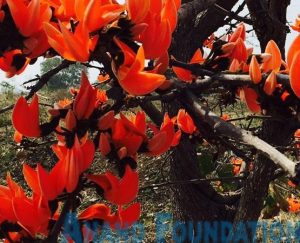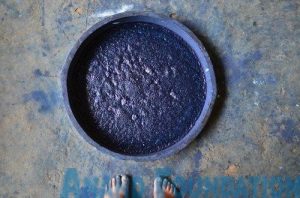NATURAL DYEING
Plants and their products attracted the attention of mankind even in Ayurveda , when practically the whole world was asleep in ignorance. Every colour has its own significance and meaning with reference to Vedas. These dyes are the oldest dyes referred to as Natural Dyes.
India was the source of earliest natural dyes known to man following the legacy of a rich tradition for using natural dyes. Natural dyes comprise those dyes &pigments that are obtained from animal or vegetable matter without chemical processing. These dyes are supposed to be auspicious from religious point of view

Dyes derived from vegetable sources
Vegetable dyes are obtained from various parts of plants and herbs including the stem, wood, roots, bark, leaves, flowers, fruits and skin of plants, which produce distinct pale to dark shades on both natural as well as synthetic fibres. Some important examples of dyes derived from plants or vegetables are turmeric, pine wood, catechu, madder, etc.
Dyes derived from mineral sources
Natural dyes produced from mineral resources include chrome yellow, chrome orange, chrome green, iron buff, Prussian blue, manganese brown, mineral khaki, etc. Mineral colours are not dyes but inorganic compounds, insoluble in water and precipitated onto the fibre by double decomposition. Certain important minerals widely used as natural dyes are Cinebor (Sangraj), Red Lead (Sindur), Laminated Red earth (Gem), Ultramarine (Lajerd), Zinc white (Sajeda), etc.
Dyes derived from insects or animal sources
Some of the most important red dyes, based on the anthraquinone structure, are obtained from insects or animals. These dyes are characterised by good light fastness. Examples of this type of dye are Lac, Kermes, Cochineal, Lichen, etc.
SOME NATURAL DYES

Indigoferatinctoria
Indian Madder -rubia cordifolia – Manjitha

Red wood powder
Tesu -Butea Sehleichera Brijuga

Jamun seeds
Anato Seed
Dyeing Process On Natural Dyes
WASHING MORDATING DYEING DEVELOPING
Scouring:- cotton/silk/wool/jute is soaked with (reetha) Aritha 50gms for 20-30 minutes.
Wash the yarn or fabric in cool water to remove the soak from the fabric.
| 1) | 1% 10.gms | 10gms TRO | 10 Ltr. water | |
| 2) | 2% | 20gms | 20gms TRO | 10 Ltr. water |
| 3) | 3% | 30 gms | 30gms TRO | 10Ltr water |

MORDANTS are applied with following bases
Ø Alum 1% 10 Gms 2% 20Gms 3% 30Gms
- Copper Sulphate
- Ferrous Sulphate
- Potassium baicromet
- Pomegranate
- Myrobalam Powder
DYEING WITH INDIGO (3% Shade)
Take 120ml water
Add 2 grams sodium hydro sulphite and 0.8 gms caustic soda.
Stir the solution well.
Take 3 pieces of cloth (cotton yarn )in this solution and rotate them for 5 minutes.
Add 18ml of standard indigo solution to dye bath and dye for
- During this entire period of dyeing the colour of the bath should be light yellow.
If it turns blueish add small quantities of
OXIDATION
After 30 minutes of dyeing take out the cloth pieces, Squeeze out the excess dye liquor in the dye bath and hang the cloth pieces to dy.
After sometime the colour of the fabric turns blue,due to the oxidation of reduced indigo by the oxygen in the air.
‘Ananda’
(Product of Unnati)
Believes in the
ELEGANCE OF VEGETABLE -INDIGO
HAND DYED SHIBORI
Vegetable Indigo
India is believed to be the oldest centre of indigo dying in the old world. It was the primary supplier of indigo to Europe as early as the Greco-Roman era. The process of extracting blue colour from green leaves of indigo plant is magical and unique. It involves various steps that need to be carried out with great timing.
The indigo pigment gets detached from glucose as leaves are soaked in water and fermented. The leaves are taken out ,leaving indigo white in the water, which when exposed to air gives out blue colour. This blue colour of indigo remains hidden until the leaf of indigo plant is fermented. After the water is whisked properly the blue colour settles down forming water clay .This sludge is then heated or sundried to be made into cakes.
Why Natural Indigo ?
Not natural indigo the safer , cleaner, more ecological choice; it has the power to heal the earth, provide work in areas of rural unemployment. It has antibacterial and fungal properties. It is skin detoxification and purification and even blood purification. It is an organic product & with vibrant depth of indigo.
SHIBORI
A Japanese form of dying that revolves around different ways of binding and folding fabric to create different patterns. The most commonly practiced with indigo dye.
Indigo dye is breath taking, actually amazing that something that comes from a plant can create such rich and vibrant shades of blue.
WHAT LOCAL DYER SAYS…..
Passing through this lane in Rajouri Garden ……I felt like talking to the dyer outside a boutique. He is from Lucknow. When I asked him about natural dyes,“he was aware that how are colours made but also said that Natural dyes are used for sampling and to prepare sample.They fade away with the time & after wash there is colour difference. Strong fixers are needed to fix the colours.


